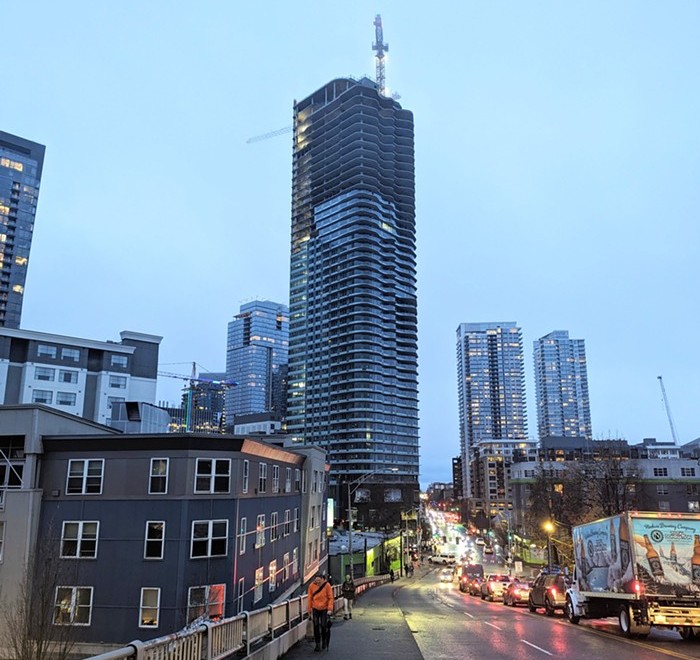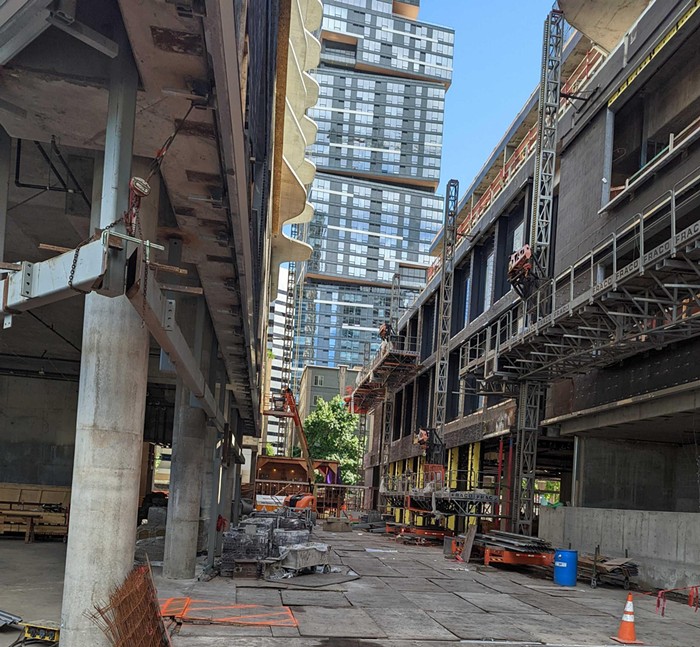
Before the first plague of the 21st century, I walked about 80,000 steps a week. In the depths of the plague, this count went down to 20,000 steps. And what I lost in steps, I gained in pounds. However, during what I call the thaw period—a combination of the transition to spring and declining number of COVID-19 cases—my stepping expanded to 55,000 a week. (My pounds, however, refuse to register this dramatic increase in activity.)
What more steps has meant is I'm seeing more of the wider city again from its sidewalks, most of which are poorly managed by the city. It has also meant that I'm remembering many of the unhappy aspects of the city, such as the kind of architecture that has dressed much of its long construction boom.
Though Seattle has a few first-rate architecture firms, such as Olson Kundig and LMN, its mid-sized fare does not hold a candle to, say, what we find in Portland, Oregon. (Many blame the sharp differences on the distinction of their design processes—Portland is warm to architectural deviations; Seattle is totally cold to them.) As a consequence, anyone who has walked the streets of the third-largest city in the Pacific Northwest can always expect to run into a pleasant surprise. Turn a corner, and there suddenly appears a mid-sized project that uses, say, wood in a striking manner.
What we can say with certainty is that in Seattle the process over the past 20 years has been a displace-and-deaden urbanism. This is the name of our game in the way that Vancouverism (skinny towers with human-scale base at the street level) is the name of the game in the second-largest city in the Pacific Northwest.
Now, the question I want to ask in this post is: Is the Seattle process making Seattle ugly? Is design-and-deaden destroying what was once beautiful? To believe so, I believe, is to have your analytical powers distracted or blunted by the aura of nostalgia.
Seattle has never been, architecturally speaking, a remarkable city. What is seen as becoming a landscape of monotonous, five-story apartment buildings has always been a landscape of monotonous single-family homes that are either the Seattle Box or, to use the words of Joshua Prince-Ramus, who participated with Rem Koolhaus in the design of the Seattle Central Library, written in "the language of bungalows or whatever they call them."
Those who are led astray by nostalgia must be forgiven at some level. An old bungalow or box has at least the attraction of being old. That is something. In traditional Japanese aesthetics, this kind of appreciation is known as sabi, which is the recognition of the long action of time on a material. ("Sabi" can be translated as "rust.")
We see the motion of the sun, the fall of snow, the battering of rain over a temporal distance that stretches the years into decades, and the decades into centuries. And so one is not admiring the architecture but rather its slow dissipation, its granular weathering, its gradual sinking into the noble condition of a ruin.
We must remember that this feeling of admiration for time's work is not specific to Japanese culture. The ancient Romans, it is said, hated Christianity because it was in a state of an innovation even in the days of Caesar, but Judaism got the state's respect. That religion was old and tested by the elements of long-past time. In our day, we are impressed with improvement (the future); with the Romans, the locus of admiration was resilience (the old, the long-weathered).

But the grand nature of Seattle's surroundings make up for its lacks of architectural beauty. A camera that takes a wide shot of the 206 is never disappointed. Whatever bad small, mid-sized, or large architectures there are in the image, they're sucked up into to the beauty of its pellucid light, its dark blues, its deep greens, its low-rolling clouds, its distant mountains.
The other interesting thing to point out is that, with Portland, Oregon, it's exactly the other way around. The city has no justice to offer a distant view. But, at the level of the street, it does reveal its many marvels. One walks Seattle for a view of the whole; one walks Portland to run into something new and unexpected.















